Shalang Dhura Peak: A Hidden Gem for Beginner Mountaineering Enthusiasts
Introduction
The Himalayas, with their breathtaking peaks and enchanting beauty, have always drawn climbers, adventurers, and nature lovers. Among these majestic mountains is Shalang Dhura Peak, a lesser-known summit standing at 5,678 meters in the Kumaon region of Uttarakhand, India. Often overlooked because of its taller neighbours’, Shalang Dhura offers untouched and unexplored landscapes that attract trekkers, beginner mountaineers, and photographers.

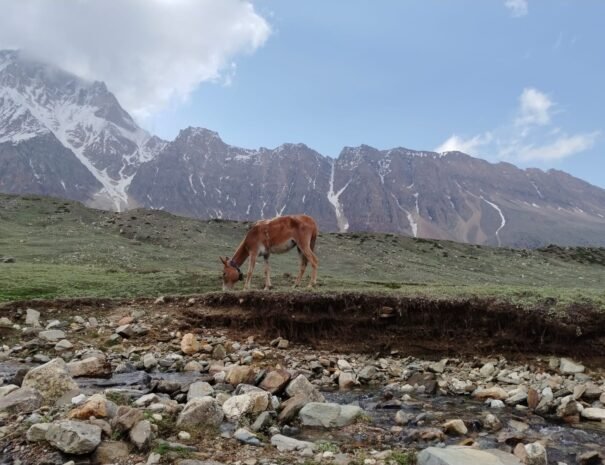
Geographical Significance of Shalang Dhura Peak
Shalang Dhura Peak is a hidden treasure located in the Johar Valley of Munsiyari, nestled within the Pithoragarh district of Uttarakhand, India. This relatively lesser-known summit rises to an impressive height of 5,678 meters and is surrounded by the pristine beauty of the Shalang Glacier. Situated on the western edge of the Himalayas, the peak lies within the Kumaon range, a region renowned for its spectacular landscapes, glacial streams, lush valleys, and towering snow-clad peaks.
The Johar Valley, where Shalang Dhura is located, has historically been significant for trade and culture. The valley served as a vital route for trans-Himalayan trade between India and Tibet until the mid-20th century. Today, it is known for its breathtaking natural beauty, making it a perfect base for exploring peaks like Shalang Dhura. The valley is dotted with picturesque villages and is home to diverse flora and fauna, adding to its appeal for nature lovers and trekkers.
Shalang Dhura stands out not only for its height but also for the unparalleled views it offers. From its summit, climbers are rewarded with panoramic vistas of some of the most prominent Himalayan giants. These include Nanda Devi, India’s second-highest peak and a UNESCO World Heritage Site; Nanda Kot, known for its striking pyramid-like shape; and Hardeol, often referred to as the “Temple of God” due to its towering, majestic presence. Additionally, the Laspa Range, with its rugged beauty and glaciated terrain, adds to the visual splendour.
The Kumaon region itself is a natural marvel, characterized by its diverse landscapes that range from verdant valleys to icy glaciers. The Shalang Glacier, in particular, is a significant geographical feature associated with the peak. It feeds several glacial streams that contribute to the river systems in the area, supporting the rich biodiversity and sustaining local communities. The glacier and surrounding areas also provide an excellent opportunity for geologists and glaciologists to study the impact of climate change on Himalayan glaciers.
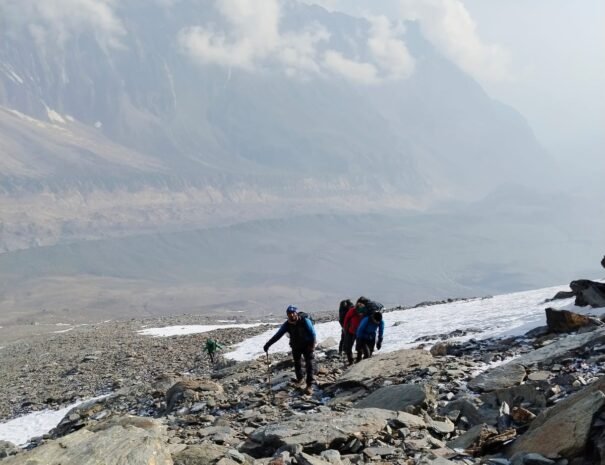
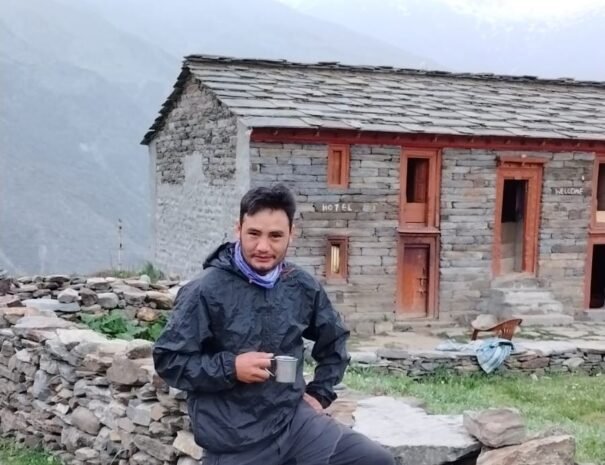
Historical and Cultural Relevance
The Kumaon region is a treasure trove of mythological and cultural significance. Shalang Dhura, often revered in local folklore, is considered a sacred mountain and a dwelling place of the gods, embodying the spiritual essence of the Himalayas. Nearby villages such as Martoli and Laspa serve as living museums of traditional Kumaoni culture. These settlements, with their time-honoured customs, distinctive architecture, and age-old practices, offer an immersive experience of a way of life that has withstood the test of time. Travelers not only encounter breathtaking landscapes but also have the chance to connect with the soul of Kumaon’s rich heritage.
Shalang Dhura Trek Itinerary
Starting Point: Munsiyari (2,200 m)
Munsiyari, known for its stunning vistas and tranquil ambiance, serves as the gateway to numerous Himalayan expeditions. The trek officially begins at Rargari, a newly constructed Border Road point near the ITBP Check Post at Bagudyar, close to the India-Nepal border. This picturesque region, rich in biodiversity, sets the stage for an unforgettable adventure.
Day 1: Munsiyari to Nahar Devi Camp (2,900 m)
- Drive: Munsiyari to Rargari (2 hours)
- Trek: Rargari to Nahar Devi Camp (6 km, 3–4 hours)
The trek starts with a short drive to Rargari, the last motorable point where road construction continues toward Milam Village. From Rargari, the trail meanders through dense forests, terraced fields, and along the serene Gori Ganga River. Nahar Devi Camp, set by the riverbank, provides a peaceful campsite to rest after the day’s trek.
Day 2–3: Nahar Devi Camp to Martoli Village (3,400 m)
- Route: Nahar Devi Camp → Laspa Gari → Laspa Village → Rilkot Camp → Martoli Village
The trek progresses through charming villages and campsites. Laspa Village and Rilkot offer glimpses into the region’s history and traditions, with Martoli Village serving as a highlight of this segment.
Martoli, a heritage village once home to over 500 families before the Indo-China War in 1962, now hosts only two families who reside here seasonally. Once a major hub on the ancient silk trade route, Martoli is a treasure trove of cultural and historical significance. Trekkers often take an extra day here to acclimatize, explore the traditional wooden houses, and soak in the warm hospitality of the locals.
Day 4–6: Martoli Village to Shalang Dhura Base Camp (4,200 m)
The trail ascends steadily, leading trekkers through lush rhododendron forests and expansive alpine meadows. As the altitude increases, the views become increasingly majestic, showcasing peaks like Nanda Devi (twin peaks) and Nanda Kot.
The Shalang Dhura Base Camp is a perfect location to rest and prepare for the summit push. The night sky here, free from light pollution, is a celestial wonderland for stargazing enthusiasts.
Day 7–8: Summit Push to Shalang Dhura (5,678 m)
The final ascent demands moderate climbing skills and the use of mountaineering gear. The summit of Shalang Dhura rewards trekkers with awe-inspiring panoramic views of the Himalayan range, a breathtaking culmination of this incredible journey.
After celebrating the summit, the descent begins, retracing the route back to Martoli Village and eventually to Rargari.
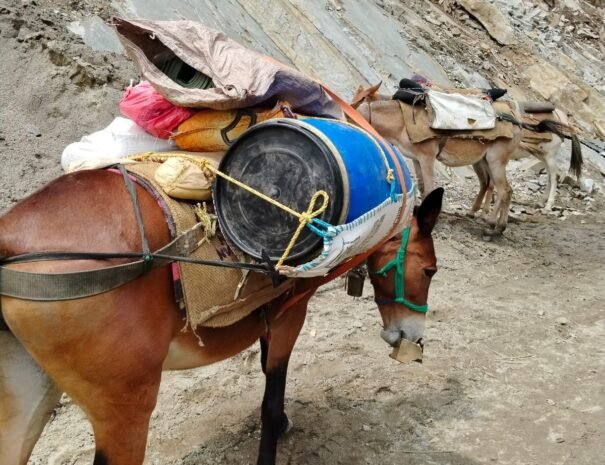
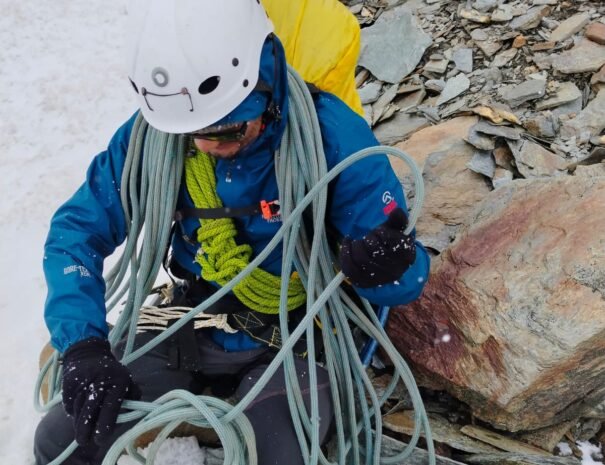
Key Highlights
- Cultural Immersion: Explore the heritage village of Martoli and learn about the traditional Kumaoni lifestyle.
- Scenic Landscapes: Trek through pristine forests, terraced fields, and alpine meadows.
- Historic Significance: Walk the ancient silk route and witness a region shaped by history.
- Biodiversity: Discover the flora and fauna unique to the Gori Ganga Valley.
- Summit Views: Marvel at the majestic peaks of Nanda Devi, Nanda Kot, and Shalang Dhura.
Flora and Fauna
The Shalang Dhura region boasts a rich and diverse ecosystem, making it a paradise for nature enthusiasts. As you trek through this pristine Himalayan landscape, you’ll be surrounded by an incredible variety of plant and animal life:
- Flora: The trail is adorned with Bhoj Patra (Himalayan birch), vibrant rhododendrons, aromatic junipers, colorful alpine flowers, and rare medicinal herbs cherished for their healing properties.
- Fauna: The area is home to iconic Himalayan wildlife. Trekkers might spot the dazzling Himalayan monal (state bird of Uttarakhand), elusive musk deer, and, with immense luck, a snow leopard. Keep an eye out for the agile bharal (blue sheep), often seen scaling the rocky slopes.
This diverse natural habitat not only adds to the scenic beauty of the trek but also underscores the ecological importance of the region.
Challenges of the Expedition
Reaching the summit of Shalang Dhura is a demanding yet rewarding adventure. Trekkers must be prepared to face several challenges:
- High Altitude: At elevations exceeding 4,000 meters, the risk of altitude sickness is significant. Proper acclimatization and gradual ascent are essential to mitigate this risk.
- Unpredictable Weather: The weather in the Himalayas can change rapidly, with sudden snowfall, strong winds, and plummeting temperatures. Being equipped with layered clothing and waterproof gear is vital.
- Rugged Terrain: The trail features steep ascents, rocky paths, and occasional river crossings. Trekkers need a good level of physical fitness and mental resilience to navigate the varied landscape.
- Technical Skills: The summit push requires moderate mountaineering skills, including the use of ropes, crampons, and ice axes. Proper training and familiarity with this equipment are critical for safety.
- Remote Location: The isolation of the region means limited access to medical facilities or rescue services. An experienced guide and a well-prepared first-aid kit are non-negotiable.
Preparation, fitness, and experienced leadership are key to conquering these challenges and ensuring a safe and memorable expedition to Shalang Dhura.
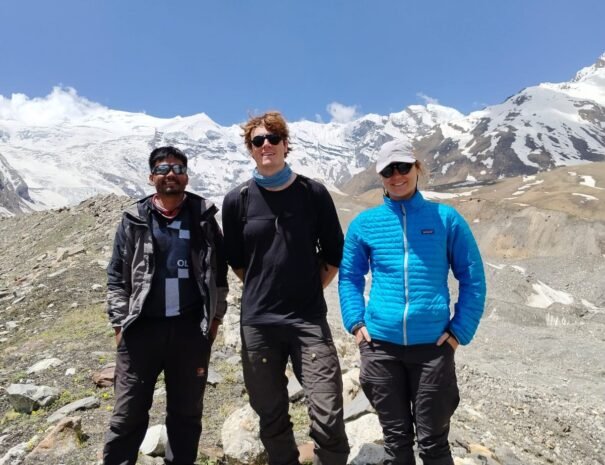
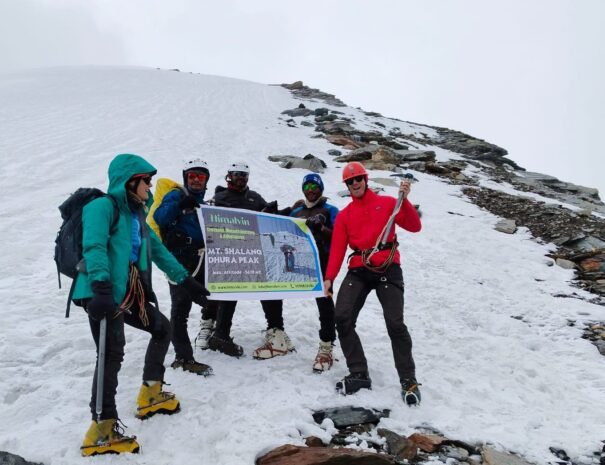
Best Time to Visit
The best time to attempt the Shalang Dhura Peak expedition is during the pre-monsoon (May–June) and post-monsoon (September–October) seasons.
- May–June: During this period, the weather is relatively stable, with clear skies offering unobstructed views of the surrounding peaks. The trails are vibrant with blooming alpine flowers and lush greenery, making the journey exceptionally scenic.
- September–October: Post-monsoon, the region transforms with golden hues of autumn, and the air is crisp and refreshing. The skies remain clear, offering breathtaking panoramas of the snow-clad peaks.
Both seasons provide favorable trekking conditions, though temperatures can drop significantly at higher altitudes, especially at night. Proper preparation and layered clothing are essential for a comfortable experience.
Why Choose Shalang Dhura Peak?
Shalang Dhura stands out as an exceptional destination for trekkers and mountaineers seeking a blend of adventure, solitude, and cultural immersion.
- Secluded and Untouched Beauty: Unlike the more popular Himalayan peaks, Shalang Dhura offers an off-the-beaten-path experience. The serene trails, unspoiled landscapes, and tranquil surroundings make it ideal for those who prefer solitude and raw natural beauty.
- Cultural Exploration: The trek provides a unique opportunity to delve into the rich cultural heritage of the Kumaon region. Passing through traditional villages like Martoli, trekkers can connect with the history, customs, and lifestyle of the local Kumaoni people.
- Perfect for Aspiring Mountaineers: Shalang Dhura is an excellent choice for beginner mountaineering enthusiasts who have experience trekking at altitudes above 4,000 meters and are eager to transition into peak climbing. The moderate technical difficulty of the ascent provides a fulfilling challenge without being overly daunting.
For trekkers and climbers seeking an adventurous journey away from the crowds, Shalang Dhura offers a rare combination of natural splendour, cultural richness, and mountaineering excitement.
Preparing for the Expedition
Proper preparation is essential for a successful and safe ascent of Shalang Dhura Peak. Here’s a quick checklist to help you get ready:
- Fitness Training
- Focus on cardio exercises like running, cycling, or hiking to build stamina for long trekking days.
- Incorporate strength training to prepare for carrying your backpack and tackling steep ascents.
- Practice endurance activities to simulate trekking conditions, such as climbing stairs or multi-day hikes.
- Gear and Equipment
- Invest in high-quality trekking boots for ankle support and grip on rugged terrain.
- Pack layered clothing to adapt to fluctuating temperatures, including insulated jackets, waterproof gear, and thermal wear.
- Essential mountaineering equipment includes crampons, ice axes, helmets, harnesses, and ropes. Don’t forget items like gloves, sunglasses, and a reliable backpack.
- Permits
- Ensure you obtain the necessary trekking and climbing permits from local authorities. These may include forest permits, Inner Line Permits (ILPs), or permissions from the ITBP (Indo-Tibetan Border Police).
- Guides and Porters
- Hiring experienced local guides is crucial for navigating challenging sections and understanding the region’s culture and history.
- Porters can help lighten your load, allowing you to focus on the trek and conserve energy for the summit push.
- Health and Safety
- Carry a first-aid kit with altitude sickness medication, pain relievers, and bandages.
- Stay hydrated and maintain a balanced diet to keep your energy levels high throughout the trek.
- Mental Preparation
- Trekking and climbing in the Himalayas require mental resilience. Be prepared for challenges such as tough weather conditions, long trekking days, and altitude adjustments.
By preparing thoroughly and respecting the demands of the trek, you’ll set yourself up for a successful and memorable expedition to Shalang Dhura Peak.
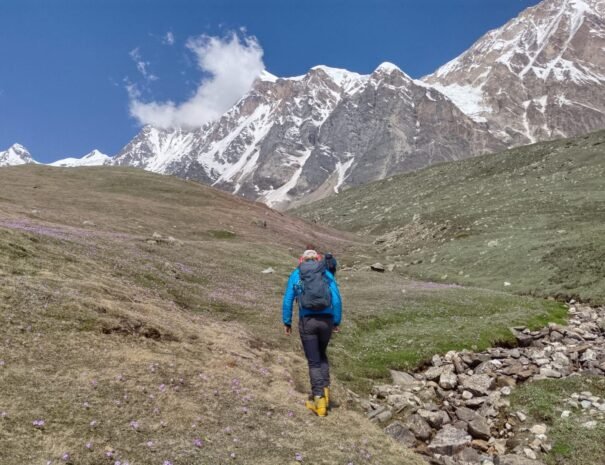
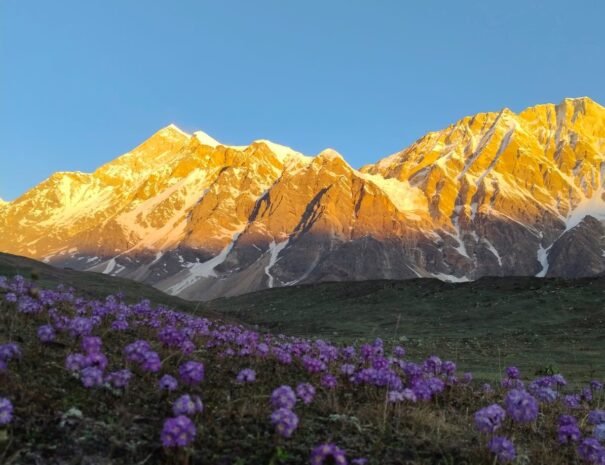
Sustainable Tourism
Exploring the natural beauty of Shalang Dhura comes with a responsibility to protect its fragile ecosystem and cultural heritage. As adventurers, we can contribute to sustainable tourism by adopting mindful practices:
- Practice Leave No Trace Principles
- Pack out all trash, including biodegradable waste, and avoid leaving any litter behind.
- Stick to marked trails to prevent damage to vegetation and minimize soil erosion.
- Camp only in designated areas to protect the natural environment.
- Respect Local Cultures
- Engage with the local communities in a respectful and meaningful way. Learn about their customs, traditions, and way of life.
- Seek permission before photographing people or their homes, and support local businesses by purchasing handmade crafts or using local services.
- Minimize Environmental Impact
- Avoid using single-use plastics by carrying reusable water bottles, utensils, and bags.
- Conserve water and energy, especially in remote villages where resources are limited.
- Use eco-friendly soaps and toiletries to prevent pollution of water sources.
- Support Conservation Efforts
- Contribute to local conservation projects or initiatives that aim to protect the region’s biodiversity.
- Spread awareness about the importance of sustainable tourism to fellow travelers and encourage them to adopt responsible practices.
By treading lightly and embracing sustainable practices, we can ensure that the untouched beauty of Shalang Dhura remains preserved for generations to come, allowing future adventurers to experience its magic.

One Comment
big88.com
Truy cập Big88.com bị báo lỗi, không biết có phải bị chặn không nhỉ? Hay là trang này đổi domain rồi? Ai biết thông tin gì về big88.com không ạ?